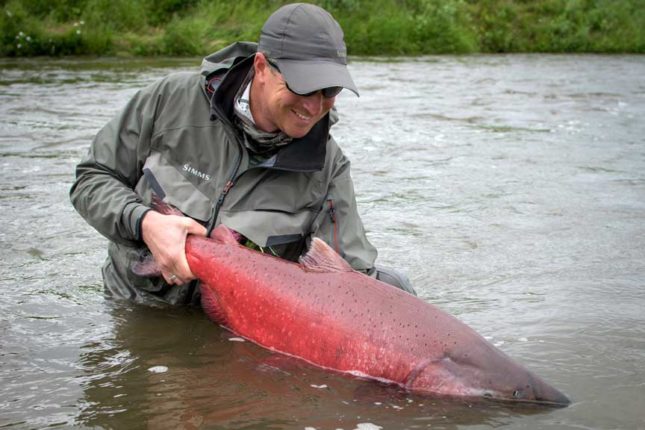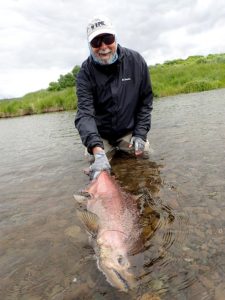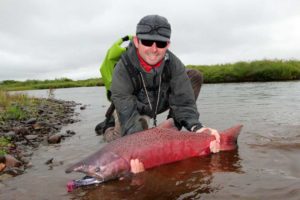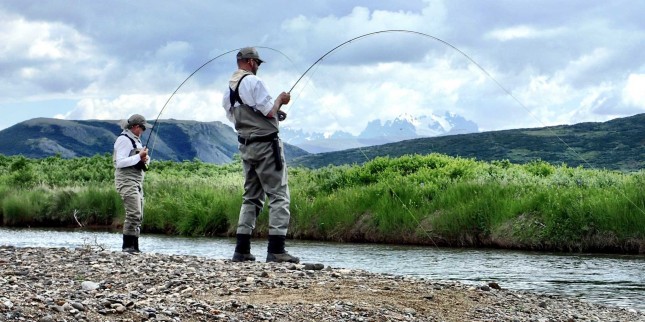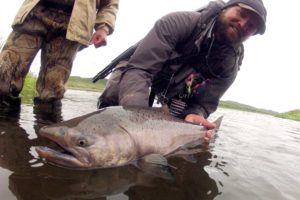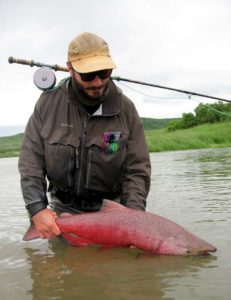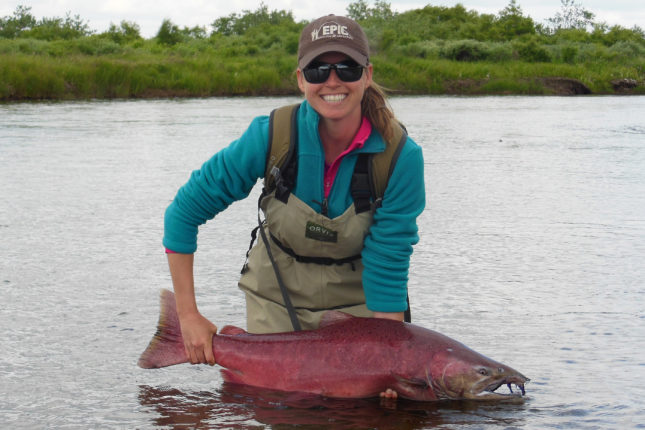Epic Blog
Seven Species Series: King Salmon
08.17.20
Part Five: King Salmon
Late July, 2018. The morning begins in a cold overcast haze. Everything drips with condensation as the first signs of life can be heard stirring from the cook tent. The sound of gas whooshing through the burners might as well be the rooster’s crow. It signals the countdown to coffee, drawing tired eyed men from their tents like a tree draws water from the soil. The week is nearly over for this group, and on this last full day in camp you can plainly see that the past five days have washed the city clean from them. Their faces are sun kissed and stubbled, their hands dark and weathered. Some of them with fingers wrapped in bandages from where the fly line has cut the skin.
They eat quickly, mostly in silence. Back home, important business awaits them, but on this day there is only one priority: to fish hard, and to fish well.
Just another walk in the park
Today I head out from camp with Leonardo and Dave. The former is a surgeon, living in the urban wilderness of southern California. His friend, Dave, is a behemoth of a man. He must be close to seven feet tall and looks like a pro basketball player, mostly due to the fact that in a former life he was one. We take our time cutting across the open tundra. Our poor brother Dave walking gingerly in wading boots that are too small for him, even though they’re the largest size you can buy. He endures, forgetting his discomfort as we draw closer to the berm of land that gives way to the creek below.
The clouds won’t lift, not today. The weather has a damp chill to it, with bouts of light intermittent rain sweeping across the rolling landscape. This is classic Bristol Bay weather: fog lorn, cold and nautical. We shuffle down a steep hillside and wade into the creek. The action comes fast. Leonardo needs little incentive to begin, and it isn’t before long that he has picked every pocket clean of its holding rainbow trout and Dolly Varden. Dave, who started the week out as a beginner to fly fishing now works the water with the confidence of a seasoned veteran. One week in Alaska will do that to you.
The bear
We progress down river fishing at a fast pace. We’re into a good spell of dollies as we approach a blind corner where the creek takes a sweeping bend to the left. As the river arcs into the bend it is joined by the outlet of a side channel; a choked corridor of head-high straw colored grass and dense willow cover. Something moves in there. I just catch it out of the corner of my eye. A bear.
Oblivious to our presence, it saunters along the high bank, peering intently into the side channel, hoping, much as we do, to spot a prize. Dave stops when he sees it, a moment after I do, and has a hard time comprehending the reality of what his eyes are seeing.
Before there’s even time to yell out at the lumbering giant it catches our scent. Rising up on its hind legs, it quickly assesses the situation, and just as quickly determines that it wants nothing to do with the three strangers who stand some fifty yards distant. Like a good bear, it runs off in the opposite direction. Pile driving through the thickets of willow and alder like a plow cuts through snow.
Finally Dave regains his voice and manages a few words, “That’s the biggest damn thing I’ve ever seen.”
Good Salmon hole
It’s nearly time to break for lunch as we wade across the creek to where it forms a deep U-shaped bend. This spot is known simply as “good king hole.” And today, with its low light and heavy overcast skies, we have just what the doctor ordered for targeting these heavy-hitting fish. Kings can be notoriously finicky eaters. While there is always the exception, cloudy overcast days are preferable for the best king salmon fly fishing.
As Leonardo and Dave set their packs down to rest their shoulders I walk towards the water’s edge to see for myself what fortune holds in store for us today.
The water here is truly deep. It’s one of the few places we fish on this creek where the depth is over head high. The water is still and dark. Here the bank falls away quickly and is covered in layers of mucky silt, making any attempt to wade into the pool nearly impossible. It takes a moment for my eyes to adjust to the glare as I peer into the depths. Then I see what I had hoped for. A faint red shadow emerges from the darkness. The longer I stare into the pool, the more of them appear. This is going to be good! But first, lunch.
King Salmon
King Salmon, or Chinook Salmon, are the largest species of salmon living on earth. They’re a member of the Pacific Salmon genus, Oncorhynchus, along with Coho, Chum, Pink, and Sockeye salmon (rainbow trout and cutthroat trout are also included in this group, as well as cherry salmon, or masu salmon). The word Chinook comes from the native dialect, Chinookan, that was shared by Native Americans living in the Columbia river gorge and the coastal regions of what are now northern Oregon and southern Washington state. Some say the word stemmed from a term meaning “strong fighters.” An apt description if true, considering the brute force of these fish. In Alaska they’re simply referred to as Kings, and if you’ve ever hooked one on a fly rod you quickly come to understand why.
Historically these fish could reach weights of over a hundred pounds. There is even a special name for the largest strains of these fish, “Tyee”, which denotes a king salmon of extraordinary size. If you study a map of the Pacific Northwest, you will see this word pop up over and over again. Now, the once prolific runs of king salmon have been whittled down to a remnant of what they once were, and the largest specimens are a thing of the past. This is especially true for the bigger lower 48 drainages of the Pacific Coast. Think of rivers like California’s Sacramento, Eel and Klamath or the Columbia and Snake of Washington, Oregon and Idaho. Alaska remains one of the last strongholds where these giants still return to their natal rivers in perennial abundance.
Play time’s over
Kings are incredibly powerful fish. Once you’ve hooked one, you’re in for it. Be ready to invest some time, blood and sweat when you cast a line to a pod of holding kings. They will take it all from you and more. Fighting them is not like fighting the other species of fish at our camp. You will quickly find yourself pairing your strength against an opponent who is equally as strong. This battle cannot be rushed. It’s an endurance match.
TAKE YOUR TACKLE SERIOUSLY!
A fish with the size and strength of a king salmon will put your rod, reel and all of your terminal fishing gear through a gauntlet of fire. Before you begin casting check your rod ferrules. Make sure they’re all snug and tight. Adjust your reel’s drag ahead of time. You don’t want to be fussing with it while you’ve got a fish on. If you can’t scratch a line in your fingernail with the hook point of your fly don’t throw it at ’em. The mouth of a king is as tough as rawhide.
Take your knots seriously. If you’ve already hooked and landed a big king I would strongly recommend re-tying the knot before you go for the next one. If you’ve been fishing a leader before coming to a pool or run that you suspect has kings in it, take it off and tie on a fresh one. There are few things as heartbreaking in the world of angling as fighting a fish for twenty or minutes just to have your fly break off in the fish’s mouth right in front of you because you didn’t tie a fresh knot or put on a fresh leader.
……to be continued here.
Find more Machete articles here.
Posted in All Posts, Fishing, OUTPOST

